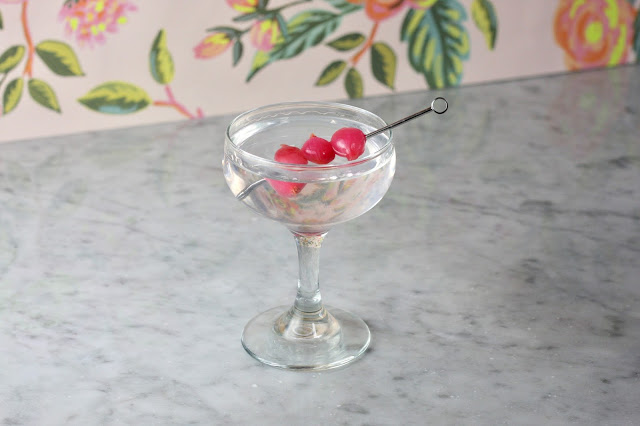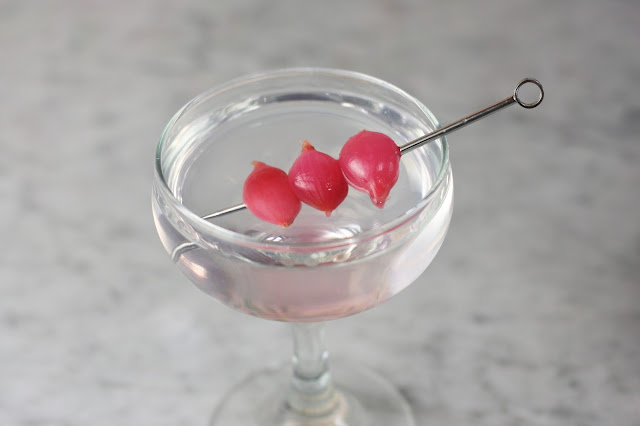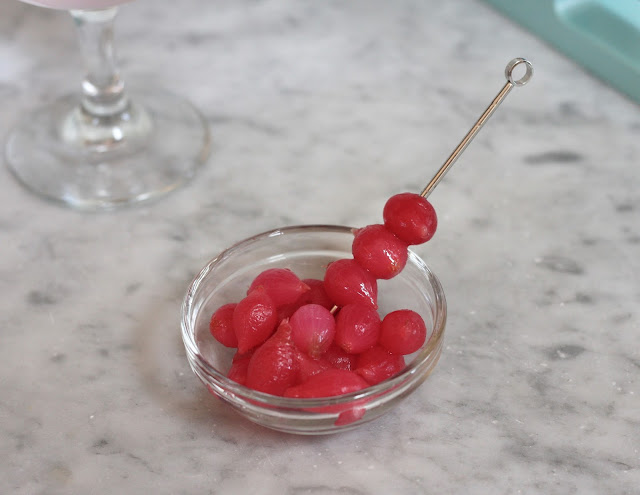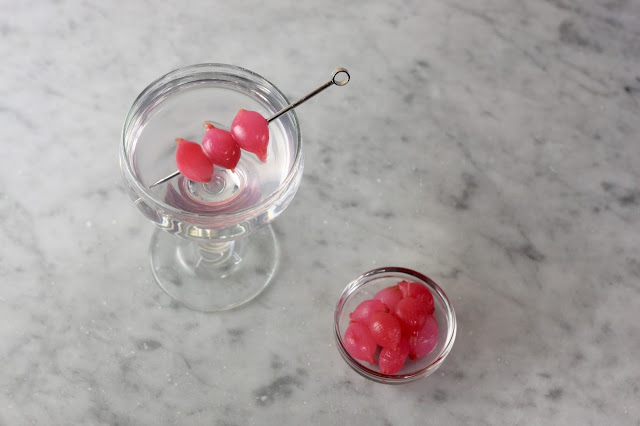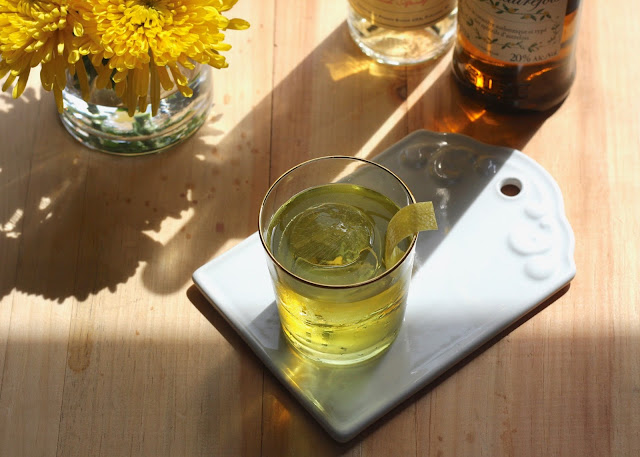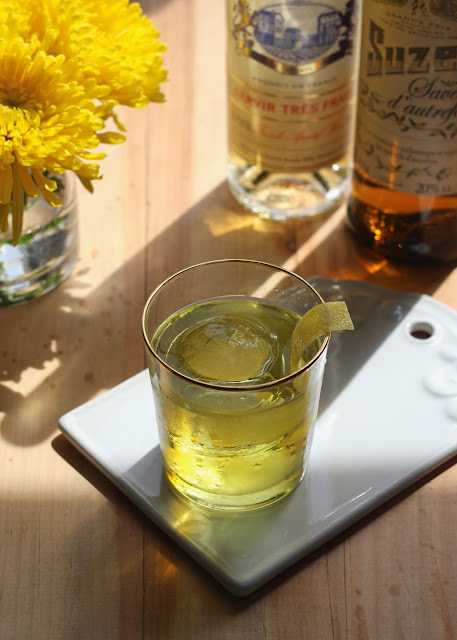I've always been a bit fascinated - and confused - by the Gibson.
Before writing this post, I didn't really know much about this classic cocktail, except that it was a Martini garnished with a cocktail onion instead of an olive or lemon twist. But if that's all it is, then why does it have a special name? And is it actually any good?
The answer to the first question is a bit complicated, but I'll get to it. The answer to the second question is yes.
If you like Martinis, especially with olives, you will like a Gibson. Well, assuming you like onions too. Like olives, onions give gin and vermouth a hint of savory flavor, and snacking on them in between sips enhances notes in the gin that you wouldn't normally taste. I'm not sure the Gibson deserves to be a cocktail in its own right, as it is definitely just a Martini variation. But the reason for that is historical, as you'll see below. And there's no denying that it's a tasty drink.
Some writers play up the Gibson as the sort of drink you have to be in-the-know to order, a signal to your bartender that you are a discerning imbiber of finely-crafted cocktails. But in my opinion, no one who fits this description would ever order a Gibson at the average bar. The quality of a Gibson hinges on the quality of its garnish, and at most bars this is going to come from an old jar of soggy cocktail onions that they've kept around on the off chance that anyone orders this obscure drink. To make a Gibson really good, you've got to use good onions. They should be briny and crunchy and - preferably - hot pink.
Well, that last bit isn't exactly part of the classic Gibson recipe. But if I was going to make my own cocktail onions, I figured I might as well have a little fun with it, so I made these beet-pickled pearl onions. It was completely worth the extra trouble. First of all, these are good - tart and briny and garlicky and just the tiniest bit sweet. And second of all, they look absolutely awesome. This is a cocktail garnish on another level. And in a drink that depends on its garnish as heavily as the Gibson, you might as well go all out.
History: I had a feeling a classic drink like the Gibson would have enough history to fill an entire book, and indeed it does. Although, as tends to be the case, most of it is apocryphal. Who, for example, was the eponymous Gibson who lent his (or her) name to this libation? And, again, why the special name at all?
Over the years, this drink has been attributed to a number of different Gibsons. In my brief research, I encountered no fewer than six - well, seven, actually, since one story involves twins. All of these tales supposedly occurred sometime between 1890 and 1920. Most are probably not true. A couple are certainly not. But it's fun to know them all nonetheless. Here are the contenders:
1. Charles Dana Gibson, the artist/illustrator responsible for the famous "Gibson Girls," challenged Charley Connolly, the bartender at the Player's Club in New York City, to improve upon the classic Martini. Connolly completely phoned it in and just swapped the olive for an onion.
2. Stockbroker Walter Campbell Gibson requested an onion in his Martini at the bar in the Ritz in Paris, and the bartender named the drink after him. This claim was included in his obituary in the New York Times.
3. Hugh Simons Gibson, a diplomat with the U.S. State Department, did not like to drink as much as his colleagues when they went out to the Metropolitan Club in D.C., so he had the bartender pour him water instead of a Martini, with an onion garnish so he could keep track of which one was his. This version is sometimes repeated with a banker named Gibson instead.
4. The drink was named after a boxing promoter named Billie Gibson.
5. There was a pair of twin sisters in Chicago with the last name of Gibson. They loved Martinis but hated olives, so would always ask for two cocktail onions as their garnish instead - two because they were twins.
6. Walter D. K. Gibson, a successful San Francisco businessman, believed that eating onions prevented colds so he would always put one in his Martini when he ordered one at the Bohemian Club (definitely my kind of healthy living).
#1 and #6 are the most popular options, though they're usually accompanied by the assertion that we'll never really know. And maybe we won't. But in an excellent article for the Wall Street Journal, Eric Felten provides fairly compelling evidence that the correct Gibson is #6 - Walter D. K. Gibson (and thanks to Doug Ford for calling my attention to it).
Felten uncovers what he says is the earliest mention of the Gibson cocktail in print, in a humorous story by Edward W. Townsend in an 1898 issue of New York World. Townsend was most famous for his Chimmie Fadden stories, a couple of which were later made into movies by Cecile B. DeMille. But he also published a series of stories featuring the upperclass Major Max and his young wife, who drink copiously and discuss such things as the merits of having whiskey and water with dinner (abominable, unless you are suffering from gout), the ongoing flirtation between the single Mr. Billings and the married Mrs. Jack, and the Major's unpublished manuscript on mushrooms. While I can't get my hands on the particular essay in question, according to Felten Major Max tells his wife, "Gin, my dear... if mixed with an equal part of dry vermouth and properly chilled makes a Gibson cocktail."
The kicker here? Townsend, who wrote these words, was the vice president of the Bohemian Club in San Francisco, where Walter D. K. Gibson supposedly enjoyed his Martinis with onions. It's not a smoking gun, but it's a compelling coincidence.
But what about those onions? Isn't that supposed to be what makes a Gibson a Gibson? Not according to Major Max, and not according to the second-oldest Gibson recipe (often credited as the oldest) in William T. Boothby's The World's Drinks and How to Mix Them. Boothby also calls for equal parts gin and dry vermouth, and says that an olive can be optionally added. So basically... a Martini. But not the Martini of the time, as you can see on the page opposite Boothby's Gibson recipe - Martinis contained orange bitters. The difference with the Gibson, as Boothby points out, is the lack of bitters, not the garnish. But the classic Martini recipe eventually lost the bitters, while the Gibson gained the onion. Maybe it was named for Walter D. K. Gibson, but the business about onions curing colds wasn't true. Maybe one of the other stories led to the iconic garnish. But it seems that the Martini and the Gibson converged on their similar recipes independently.
One thing is for sure - the Gibson is a cocktail that shouldn't be neglected. Major Max told his wife, "I purpose writing about its merits until it shall be crowned with the appreciation of mankind." A noble aim, and one I hope I've furthered here.
Gibson
2 1/2 oz. gin1/2 oz. dry vermouth
Beet-pickled cocktail onions for garnish (recipe below)
Combine gin and vermouth in a mixing glass with ice and stir until well chilled. Strain into a chilled coupe or cocktail glass and garnish with three cocktail onions on a pick.
Beet-Pickled Cocktail Onions
1 cup apple cider vinegar1 cup water
3 garlic cloves, crushed
3 tbsp. sugar
3 tsp. whole black peppercorns
1 tbsp. kosher salt
4 small red beets, cooked and roughly chopped (I used Love Beets; you can also try canned, check your grocer's salad bar, or roast your own)
1 cup pearl onions (I bought mine frozen and thawed them out)
Combine the vinegar, water, garlic, sugar, peppercorns, and salt in a saucepan and bring to a simmer, stirring until sugar is dissolved, about 5 minutes. Let cool for 15 minutes. Combine beets and onions in a mason jar and pour the vinegar mixture on top. Let sit at room temperature for 2 hours, then transfer to the fridge and let sit at least overnight.
Onion recipe adapted from this one by Food & Wine.
Besides the sources linked above, historical information also came from Slate, Elemental Mixology, and Paste Magazine.

